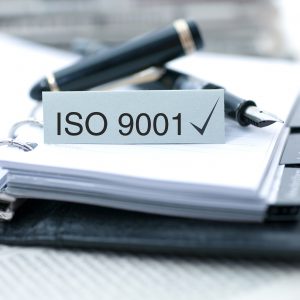ISO 9001 is the international standard for quality management.
You may have come across organisations that are certified to ISO 9001; perhaps you’ve seen the ISO 9001 certification logo on a lorry, work van, or on a website. An ISO 9001 certification can provide all kinds of benefits for both the organisation and its customers.
If you’re considering putting a Quality Management System (QMS) in place at your organisation, but aren’t sure if you’re ready to commit to the project, it may help to have a look at our blogs about the requirements, and the certification process. We also have a handy video which explains the essentials of ISO 9001 in less than 90 seconds.
ISO 9001 has been in existence since 1987, when it was known as BS5750. It was called the quality assurance standard. ISO 9000 was the guidance document. It was designed to help organisations meet the needs of customers and stakeholders while also meeting regulatory requirements relating to products and services.
The latest incarnation is ISO 9001:2015, which is a similar layout to the previous one, ISO 9001:2008 in that it follows a plan, do, check, act model in a process-based approach. The main development is the focus on risk-based thinking.
If you’ve been considering implementing a Quality Management System, and think that ISO 9001 might be the way forward, here is some essential information to help with the decision.
What does ISO 9001 look like?
ISO 9001 is made up of 10 clauses, many of which appear in a very similar format in other ISO Standards. This is designed to make it easier to combine multiple systems and standards together.
You can find more information on what the clauses involve in our requirements blog, but here’s a quick reference:
- A Policy
- The Control of Processes
- Identifying Interested Parties
- Identification and Planning to Address Risks and Opportunities
- Objectives
- Planning of Changes
- Support
- Operational Control
- Design and Development
- Control of External Providers
- Production and Service Provision
- Performance Evaluation
- Non-Conformance Management
It may look daunting, but we promise it’s not as complicated as it looks. You may find that some of the requirements are already in place, and you might want to consider getting an ISO 9001 Consultant involved to help you work through the project. An experienced consultant will be able to translate the jargon, adapt existing processes to meet the requirements of the standard, and just generally provide support to help the project run as smoothly as possible.
Who needs to be involved?
Your whole organisation should be aware of the QMS, as they all have a part to play in making sure that it does what it should. In particular, top level management must be actively involved (even if they delegate the individual tasks), as they retain overall responsibility for the success of the QMS.
Most organisations appoint an individual or team of people to manage the QMS on a day-to-day basis, and sometimes this involves the support of an external quality consultant. This person or group of people take the main responsibilities for ensuring the requirements of the standard are met, that processes are functioning as they should, and that any issues are handled appropriately and in good time.
Some requirements can also be shared out among individuals, allowing those with the knowledge and experience to help maintain the system. For example, sales and business development teams often assist with the Interested Parties related requirements, line managers can help identify Objectives, and everyone can follow an issue reporting process to identify and properly manage non-conformances and improvements.
How long will it take?
How long it takes to properly implement a QMS and achieve certification really depends on the organisation. It is essential to have the adequate resources such as individuals to manage the QMS, the time to do the things that need doing, and the support of everyone in the organisation.
However, as a guide we suggest a comfortable amount of time is 6-9 months. At minimum, the QMS must have been fully active for 3 months before you can achieve certification, as certification bodies require a full 3 months of evidence for auditing purposes.
I still have questions…
Here at Assent, we understand that an ISO certification project can feel daunting. If you’d like to chat to us and get some more information, we’re happy to help. You can reach us HERE.


